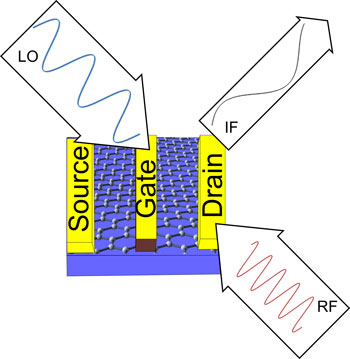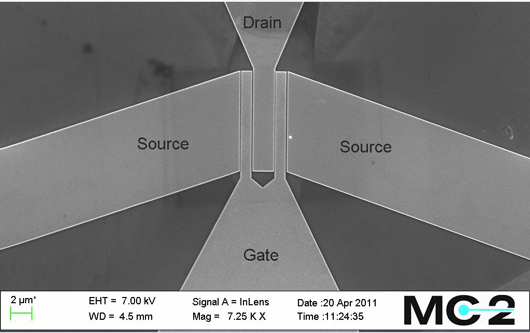- News
3 January 2012
Chalmers demos first subharmonic graphene FET mixer at microwave frequencies
In research supported by the Swedish Foundation of Strategic Research (SSF), Chalmers University of Technology in Gothenburg, Sweden claims to have demonstrated for the first time a novel subharmonic graphene field-effect transistor (FET) mixer at microwave frequencies (O. Habibpour et al, IEEE Electron Device Letters, vol 33 (issue 1, January 2012) p71; DOI: 10.1109/LED.2011.2170655). The researchers reckon that the mixer can provide new opportunities in future electronics, as it enables compact circuit technology, the potential to reach high frequencies, and integration with silicon technology.
 Combining two or more electronic signals into one or two composite output signals, a mixer is a key building block in all electronic systems. Future applications at terahertz (THz) frequencies (such as radar systems for security and safety, radio astronomy, process monitoring and environmental monitoring) will require large arrays of mixers for high-resolution imaging and high-speed data acquisition. Such mixer arrays or multi-pixel receivers need new type of devices that are not only sensitive but also power-efficient and compact, says Chalmers.
Combining two or more electronic signals into one or two composite output signals, a mixer is a key building block in all electronic systems. Future applications at terahertz (THz) frequencies (such as radar systems for security and safety, radio astronomy, process monitoring and environmental monitoring) will require large arrays of mixers for high-resolution imaging and high-speed data acquisition. Such mixer arrays or multi-pixel receivers need new type of devices that are not only sensitive but also power-efficient and compact, says Chalmers.
Figure 1: Schematic of subharmonic graphene-FET mixer. The LO and RF signals are fed to the gate and drain terminals, respectively, and the IF signal is extracted from the drain terminal.
First produced in 2004, graphene has rapidly gone from curiosity‐driven to applied research. Its ability to switch between hole or electron carrier transport via the field effect allows a unique niche for graphene in RF IC applications. Due to this symmetrical electrical characteristic, the Chalmers researchers have fabricated a grapheme FET (G-FET) subharmonic resistive mixer using only one transistor. Hence, no extra feeding circuits are required, making the mixer circuit more compact compared with conventional mixers. As a consequence, the new type of mixer requires less wafer area, and can open up opportunities for advanced sensor arrays, e.g. for imaging in the millimetre-wave and even sub-millimetre-wave ranges as G-FET technology progress.
“The performance of the mixer can be improved by further optimizing the circuit, as well as fabricating a G-FET device with a higher on-off current ratio,” says professor Jan Stake of the Department of Microtechnology and Nanoscience’s Terahertz and Millimetre Wave Laboratory. “Using a G‐FET in this new topology enables us to extend its operation to higher frequencies, thereby exploiting the exceptional properties of graphene. This paves the way for future technologies operating at extremely high frequencies,” he adds.
In addition to enabling compact circuits, the G-FET provides the potential to reach high frequencies due to the high carrier velocity in graphene, and the fact that a subharmonic mixer only requires half the local oscillator (LO) frequency compared to a fundamental mixer. This property is attractive especially at high frequencies (the THz range) where there is a lack of sources providing sufficient LO power.

Figure 2: SEM image of a subharmonic graphene-FET mixer, which uses the ability in graphene to switch between hole or electron carrier transport via the field effect.
Moreover, the G-FET can be integrated with silicon technology. For example, it is compatible with complementary metal oxide semiconductor (CMOS) technology, and can be used in CMOS electronics for backend processing on a single chip, among other things.
